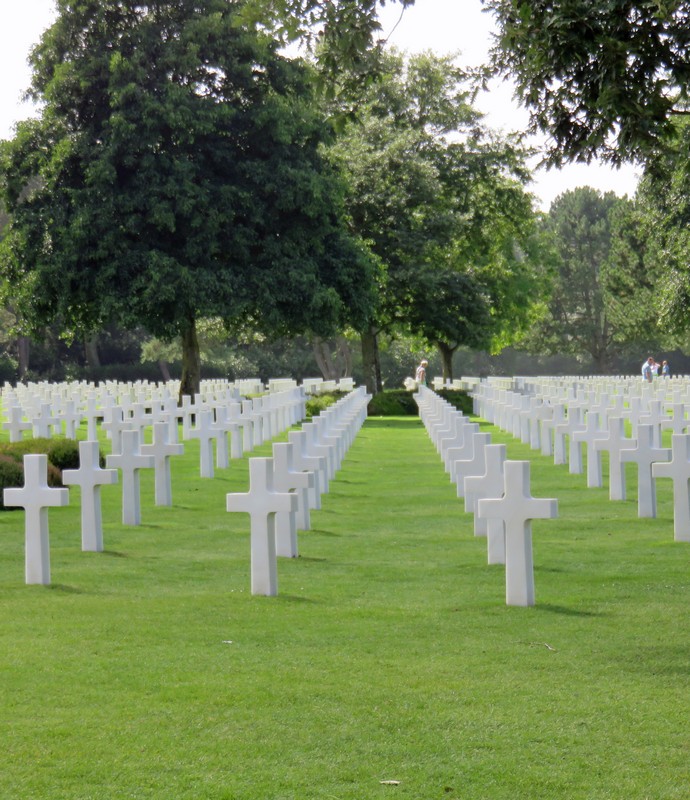Perspectives on Our Past
I often write about the importance of history, tradition and heroes in cementing the bonds between us as initiates and chapters of Sigma Nu. In this column, I focus on our heroes.
We have many awards and honors that we bestow on those brothers and chapters that accomplish extraordinary feats. We have the Hall of Honor, the Hall of Fame, the Merit Awards for our collegiate Man-Scholar-Athlete-Talent of the Year, our Alpha Alumni Affiliates Program, the Rock Awards and many others. Although we do a good job of honoring our “heroes”, we have one group of real heroes we’ve never adequately recognized and honored.
Since our founding in 1869, combat action has resulted in the death of almost 700 young Sigma Nu initiates in the wars fought by the United States and Canada. I say “young” because most of them were in their early to late 20s at the time of their death.
To rectify this omission, we are erecting a new monument at the Memorial Flag Pavilion at our Lexington headquarters to recognize these brave and courageous men for their sacrifice on the battlefield. It will consist of a wall with a bronze plaque for each war, listing the names and chapters of those killed. But before I get into the details, let me tell you about just a few of these extraordinary Sigma Nu brothers.
First Lieutenant Thomas Dwyer Amory (VMI/Cornell)
(October 17, 1893 – October 2, 1918)
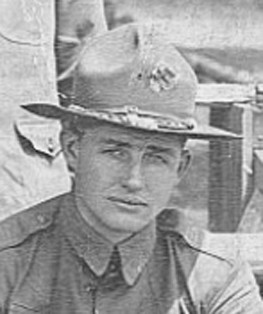
Thomas Dwyer Amory was born in Duluth, Minnesota, but the family relocated to Wilmington, Delaware. In 1910, he entered Virginia Military Institute and was initiated by our Alpha Chapter as Alpha 161. After two years, he transferred to Cornell University and affiliated with our Gamma Theta Chapter as number 136. His younger brother, George S. Amory, was also initiated into the Cornell chapter in 1912. After two years at Cornell, Tom transferred back to VMI and graduated with the Class of 1916.
After graduation, Tom moved to Boston to work as a chemist, but on April 6, 1917, the United States entered World War I. Less than two months later, due to his extensive military training at VMI, Amory enlisted along with his younger brother, George. The army sent Tom to officer training camp at Plattsburg, New York, and in September 1917 he was commissioned a Second Lieutenant and shipped to France. He served with Company D of the 26th Infantry Regiment, First Division, the same regiment as Archibald Roosevelt, the son of President Theodore Roosevelt.
During the crossing to France, he was selected, along with three others, to train at a British school for Scouting. Forward scouts, and their platoons, went in advance of the rest of the soldiers to determine the location and placement of the enemy – a very skilled and dangerous job. Enemy action killed two of the scouts selected on the crossing within 60 days of the end of their training.
The War
In May 1918, the Germans seriously wounded Amory at Montdidier, France, four days before sixty-two percent of the officers in his regiment died in Cantigny, France. It was the first American battle and offensive in World War I. In August, 1918, he returned to his unit even though not fully recovered from his wounds. He just wouldn’t allow himself to be kept under medical treatment any longer when others were still fighting. In September, the army promoted him to First Lieutenant.
On October 2, 1918, the enemy position needed to be determined and volunteers were asked to serve as scouts. Amory was selected to lead the reconnaissance mission. What happened next is best told by the Commander-in-Chief’s citation for the Distinguished Service Cross awarded to Amory posthumously:
“Lieutenant Amory took out a patrol of sixty-four men, penetrating the enemy’s lines for the purpose of reconnoitering terrain over which an advance was to be made on the following morning. When his patrol was fired on by machine-guns from all sides, [Amory] led three of his men forward to clear the machine-gun nests, placing the rest of his men under cover. He succeeded in overcoming one of these nests and killing the crew; but as he was advancing on another gun, located about ten yards away, Lieutenant Amory was killed by a machine-gun bullet, his last words being: ‘We will take that nest or die trying.’”
He did both. However, with the war raging around them, there was no way his body could be sent back to the command post for subsequent burial. Thus, his men buried him near where he fell.
The book, Record of Service in the World War of V.M.I. Alumni and Alma Mater, contains the following article “Back to the Battlefields” by Sergeant Charles W. O’Connor, one of Amory’s men. It describes very poignantly the search to recover his remains from the battlefield. In January, 1920, Sergeant O’Connor accompanied Amory’s brother, George S. Amory (Cornell), to France.
“My particular mission was to try to locate on a desolate hillside, the grave of an Officer of my Company, Lieutenant Thomas D. Amory…We had buried Lieutenant Amory in pitch darkness at midnight…after a mad day, near the hillcrest where he had been killed by machine-gun fire, while leading a daring day-light patrol. The grave had been marked by a small cleft stake, bearing a silver identification tag – the only thing we could find, feeling in the darkness.
Later search had failed to find the burial place. It had not been possible for me to return because I was hit, three days later, on patrol.
At the request of Lieutenant Amory’s family, I sailed last December to search for the grave. I knew the spot was near a small town and a cross roads. And I felt I could go back there and locate the wrecked stable, the red-roofed farmhouse, the row of trees, the ridge, the pathway, and the little stake at the foot of the slope.
But halfway along the road from Gegness to Exermont I caught sight of a ridge that seemed familiar. I jumped from the car, looked about, then, once more for me, I was back in it – back without the crash of shells, and the whistle of machine-gun bullets, and the sight of running men. There was the wrecked stable at the crossroads, the red-roofed farmhouse from which the murderous fire had come, the little stream – the very planks – we had dashed across. And there, on the ridge, were the shelter-holes where my Company had dug in at night, the tree that marked Company P. C., the ravine where battalion headquarters had been and the dressing station.
Straight to the end of the row of trees we went. There, in the weeds, with thumping heart, I saw the little cleft stake, and the silver identification tag, and the pile of stones.”
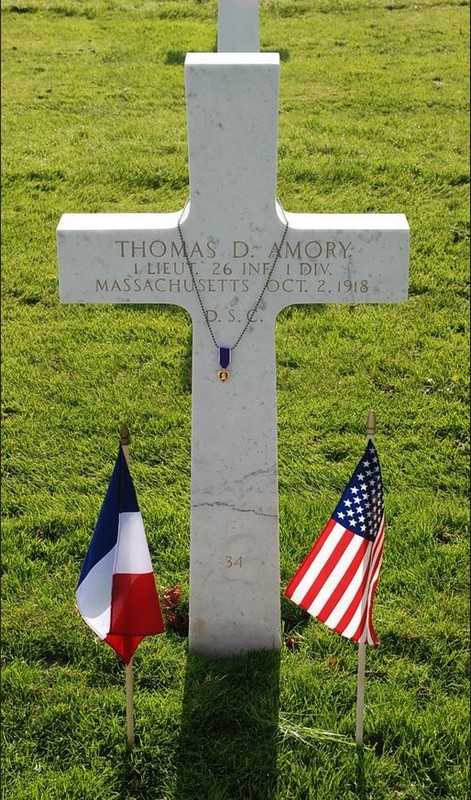
Lieutenant Amory’s remains were exhumed and reinterred at the Meuse-Argonne American Cemetery and Memorial in Lorraine, France. Another white cross had joined those of so many, many other brave soldiers who made the ultimate sacrifice.
Exceptional Valor Recognized
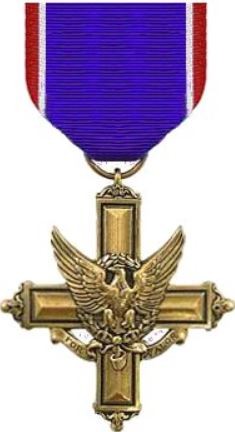
General Pershing, the U.S. Commander of the American Expeditionary Force on the Western Front later selected Lieutenant Amory’s action as one of the hundred bravest acts performed by the two million American soldiers in World War I. For his valor, Amory was awarded a Distinguished Service Cross and nominated for, though not awarded, a Medal of Honor.
On November 11, 1928, the intersection of Commonwealth and Dartmouth in Boston, Massachusetts was named Lt. Thomas D. Amory Square in his honor.
Captain Andrew Allison Haldane (Bowdoin)
(August 22, 1917 – October 12, 1944)
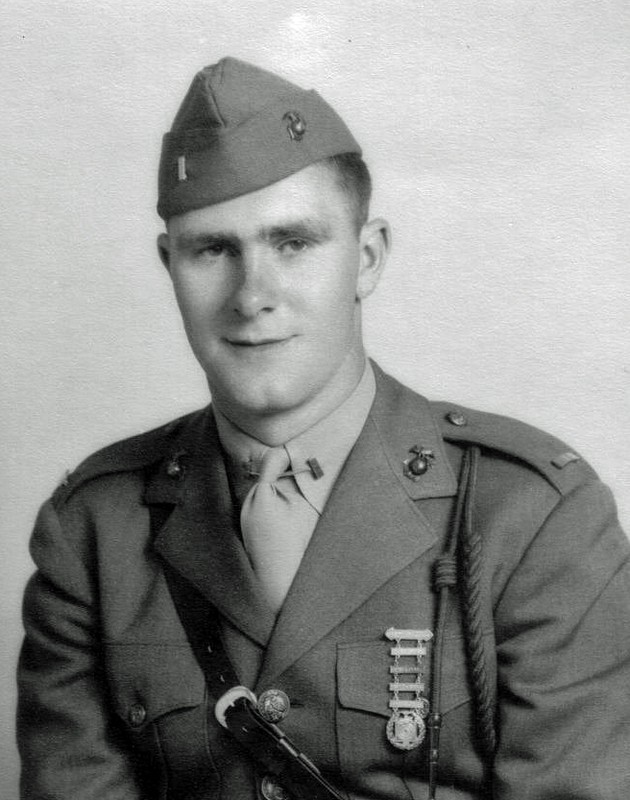
Andrew “Andy” Haldane, nicknamed “Ack-Ack”, was a United States Marine officer who fought in the Pacific theater during World War II. According to one source, he is one of the most revered figures in the history of the Marines. The HBO series “The Pacific” featured his story of leadership and courage.
Haldane was born in Lawrence, Massachusetts, and attended Searles High School in Methuen, Massachusetts, where he graduated in 1935. He enrolled at Bowdoin College in Brunswick, Maine, where the Sigma Nu Chapter initiated him as Delta Psi Chapter 310.
Haldane was one of Bowdoin’s most famous athletes and an all-around leader on campus. He played football all four years and was named the captain of the team in his senior year. Andy also played three years of baseball. He was the president of his class, president of the student council and was voted most popular man of his class and the outstanding Sigma Nu at Bowdoin.
War in the Pacific
In October 1941, the U.S. Marines commissioned him and sent him to Officer’s Training School at Quantico, Virginia. Upon graduation, he was promoted to Second Lieutenant and sent into the Pacific War. His first assignment was as the leader of a machine-gun platoon on Guadalcanal. Later he was promoted to First Lieutenant and subsequently to Captain.
He earned a Silver Star medal during the Cape Gloucester battle in New Britain during January 9-10, 1944. The citation for this medal reads in part:
“With utter disregard for his own personal safety Captain Haldane fearlessly directed the attack of his company against strongly emplaced enemy positions on Aogiri Ridge in the face of intense machine gun, mortar and sniper fire. Later, in the pitch darkness of early morning he valiantly led his command in a determined stand against five vicious counter attacks by a superior number of fanatical Japanese troops, thereby contributing in a large measure to securing the beachhead line of the airdrome.”
He and his company were in the first wave that landed on Peleliu Island, Japan, in September 1944. The Marine Corps Museum calls Peleliu the “bitterest battle of the war for the Marines”. The casualty rate was 40%, the highest casualty rate of any amphibious assault in American military history - 1,800 Marines died during the battle.
The original estimate was that the Marines would successfully take the island from the Japanese in three days. However, this time estimate was completely wrong and the battle was far more brutal and intense than anyone predicted. Although depleted and exhausted, on October 12, 1944, almost a month after the assault began, Captain Haldane’s company was holding a ridge with enemy sniper fire coming at them from three sides.
To determine the enemy’s position required a man to crawl to the top of the ridge, quickly glance over and duck back down to avoid a sniper hitting him. Captain Haldane was never one to send his men into a situation he would not do himself. As a former machine-gunner, he understood what information his gunners required. Haldane crawled to the edge, lifted his head just above it for three to four seconds and started to speak. However, no words came out of his mouth. His men heard a “thwack’ and knew immediately what it meant. A sniper had been surveying the ridge at that exact time and did not miss. There was no use in calling for a medical corpsman; Captain Haldane was likely dead before gravity even pulled his head back down to the ground.
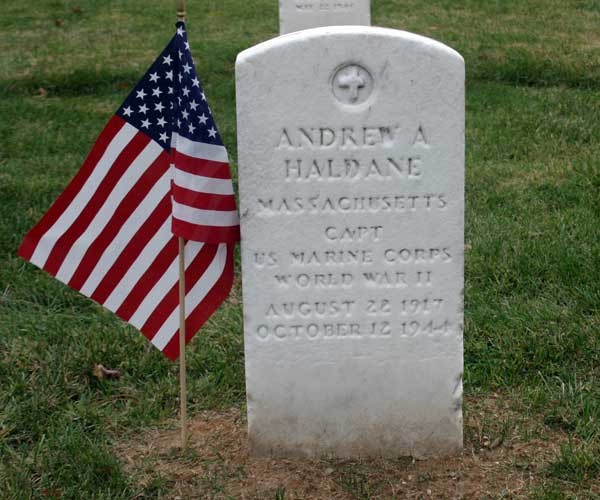
“The Finest Marine Officer I Ever Knew”
The President’s Citation awarding Captain Haldane a Gold Star in lieu of a second award of the Silver Star reads as follows:
“… to Captain Andrew A. Haldane…for conspicuous gallantry and intrepidity as Commanding Officer of Company K, Third Battalion, Fifth Marines, First Marine Division in action against enemy Japanese forces on Peleliu and Ngesebus Islands, Palau Group from 15 September to 12 October 1944. A splendid and fearless leader, Captain Haldane repeatedly led his assault company through intense hostile artillery and small arms fire to rout the enemy from strongly held positions with heavy losses. On 12 October, he personally directed a platoon of his men against a firmly defended cave on an important ridge continuing his heroic efforts until mortally wounded by Japanese sniper fire. By his inspiring courage and disregard for personal safety, Captain Haldane contributed materially to the success of our forces in these strategic areas… He gallantly gave his life for his country.”
Captain Haldane’s remains were returned to the U.S. and buried at Arlington National Cemetery in Arlington, Virginia.
Descriptions of Andrew Haldane indicate what an outstanding leader he was. He was always concerned with the welfare of his men. He never needed to raise his voice in command, because no one ever doubted who was in charge. His troops loved him for expecting nothing less of himself than he expected of them.
One of the men who served under him, Eugene Sledge, wrote in his book With the Old Breed: At Peleliu and Okinawa the following:
“Capt. Andy Haldane…commanded our individual destinies under the most trying conditions with the utmost compassion. We knew he could never be replaced. He was the finest Marine officer I ever knew. The loss of many close friends grieved me deeply on Peleliu and Okinawa. But to all of us the loss of our company commander at Peleliu was like losing a parent we depended upon for security – not our physical security, because we knew that was a commodity beyond our reach in combat, but our mental security.... We had lost our leader and our friend. Our lives would never be the same. He was able to put enough of himself aside to address the concerns of his men. I don’t want to sound cliché, but I think he’s the best that we produced. And who knows what he could have become? You can’t help but wonder what he would have been had he lived out his life.”
First Lieutenant Tom Emerson (Oklahoma)
(March 1, 1944-March 24, 1969)
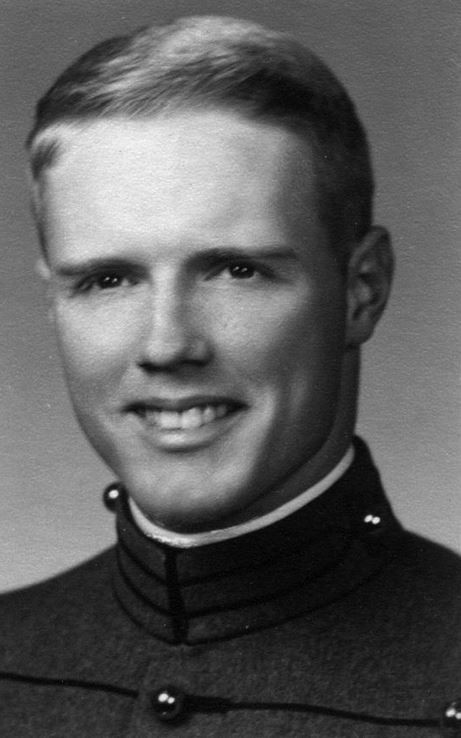
Tom “Emo” Emerson was born and spent the first ten years of his life in St. Joseph, Missouri. In the mid-1950’s his family relocated to Oklahoma City, Oklahoma, and he graduated from Northwest Classen High School.
Tom’s father had served in the horse cavalry and, while in high school, Tom became interested in a military career as a result of his German language teacher. Colonel Caldwell had served in the army and talked often about the experience to his students.
After high school, Tom enrolled at the University of Oklahoma and in 1963 was initiated by our Delta Epsilon Chapter as badge number 1129. However, his desire for a military career compelled him to seek admission into the United States Military Academy. After a year at Oklahoma, he received his appointment and in 1963 transferred to West Point.
Red-headed and blue-eyed and with a twinkle in his eye and constant smile, Tom had a mischievous side to him and was known as a prankster in high school and at the Academy. In a memorial to him posted on the West Point Organization website is the following example from one of his friends:
“One of the many pranks for which Tom is remembered in high school was encouraging his male friends to dress as female cheerleaders and try out for the squad. Tom and his friends ended up talking to the principal about their inappropriate dress and cheer!”
Tom graduated with the West Point Class of 1967. He did very well in academics and athletics. At the Academy he played football, gymnastics and ran track. He was also known to do well with the women due to his charm.
After graduation he attended Ranger School and Armor officer’s courses at Ft. Knox. After a further stint at Ft. Bragg, he was assigned to the Third Squadron, Fifth Cavalry, Ninth Infantry Division in Vietnam as a platoon leader. His Vietnam tour started on September 15, 1968.
On March 24th 1969 he was killed leading his platoon against the enemy. His Silver Star Medal citation, which he received posthumously, describes his death:
“LT Emerson distinguished himself by exceptionally valorous action on 24 Mar 1969 on a reconnaissance mission in Quant Tri Province. After his unit became heavily engaged with a large, well-entrenched enemy force, LT Emerson courageously led his men in an assault against the hostile emplacements. Maneuvering through intense enemy fire, he repeatedly exposed himself to the fusillade to direct his men and personally fire against the enemy. Although seriously wounded during the assault, he continued to lead his men until the enemy had been forced to retreat, but then he succumbed to the wounds he received.”
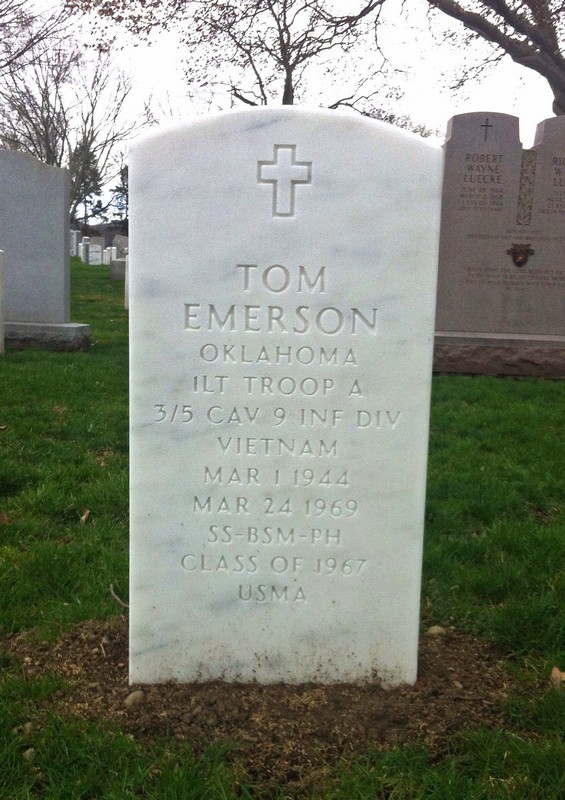
His remains were returned to the United States and interred at the United States Military Academy Post Cemetery at West Point, New York.
The War Memorial Wall and Remembrance Album
These three brave young men made the ultimate sacrifice for our freedom and way of life. As I said at the start, there are almost 700 Sigma Nu initiates killed in action on the battlefield. Each of their stories is just as poignant and heartbreaking. They were someone’s sons, brothers, husbands, fathers and friends. It’s important that their stories are told and that these men are not forgotten. It’s the very least we can do for what they did for us.
Although I have room in this column for only three, we intend to remember and honor them in a Remembrance Album with a page for each initiate that includes a photo and description of them and the circumstances of their death. We will display this album at headquarters and make it available to all visitors who come through our door. Those who stand at the War Memorial Wall and see a name and a chapter will be able to find out more about these heroes from the album.
Our plan is to add the War Memorial Wall to the existing Robert L. Marchman, III Memorial Flag Pavilion. The Pavilion, dedicated in 2004, was originally established to honor all our veterans who served in the military. In addition to a wall, it consists of bricks on which chapters, families and friends can have the name of a Sigma Nu veteran etched.
The new War Memorial will consist of a separate wall with a bronze plaque for each war listing the names and chapters of those we lost. There will also be benches available for those who choose to sit and contemplate the meaning of the Wall and the men who fought and died so bravely.
The current plan is to officially dedicate the War Memorial Wall on the 100th anniversary of the end of World War I, November 11, 2018. We will invite families, alumni, chapters, friends and the public to the ceremony.
Although the design for the wall is not yet final, below is one artist’s (Michael Jaszczak - Case Western Reserve) conception of how it might look. The final design will complement the existing Flag Pavilion and the role it plays in honoring our service veterans.
Whether you served in the military or not, I hope you will join in making sure these men are not forgotten. We need to honor them for what they sacrificed for each of us and our country. We will recognize donors with a brick at the site of the Wall to reflect their commitment to remembering these men.
To complete the construction of the War Memorial Wall and the other plans to honor our fallen heroes, we need to raise $250,000. To date, we have successfully raised over $130,000 towards that goal. Please help us by making a tax-deductible contribution for this important monument. Go to the Sigma Nu Educational Foundation website at https://www.sigmanu.org/warmemorialwall and make a donation or send a check to:
Sigma Nu Educational Foundation
PO Box 1869
Lexington, VA 24450.
It’s the least we can do for these brothers who gave their all on the battlefield.
I can think of no better way to end this column than with words from a poem written by Archibald MacLeish during World War II.
“The young dead soldiers do not speak, Nevertheless they are heard in the still houses: who has not heard them?
They say, We have given our lives but until it is finished no one can know what our lives gave.
They say, Our deaths are not ours: they are yours: they will mean what you make them.
They say, Whether our lives and our deaths were for peace and a new hope or for nothing we cannot say: it is you who must say this.
We were young, they say. We have died. Remember us.”
They have done their duty - to remember and honor them is ours.
